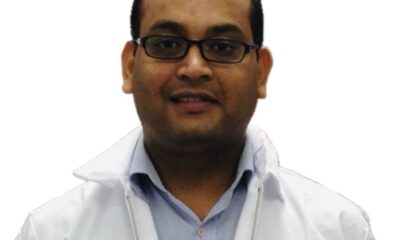Jaya Singh: Engineering Solutions Through Applied Biotechnology
One step, one challenge at a time. That’s how she works.
Jaya Singh’s journey in science began far from any lab bench. As part of her master’s research, she spent months walking through the forests of the Pench Tiger Reserve in India, collecting carnivore fecal samples to estimate the tiger population using DNA extracted from the feces. It was up-close, high-pressure work that required focus and calm, especially when working near recent kill sites.
That project provided her with more than just field experience. It sparked a lasting interest in how living systems work from the inside out. What began in wildlife biology grew into a focus on molecular biology, microbial systems, and problem-solving in applied research.
Education and Early Research
Jaya earned her BSc in Biochemistry at Bundelkhand University and completed her MSc in Biochemistry from Devi Ahilya Vishwa Vidyalaya. She went on to earn a PhD in Biotechnology from Jawaharlal Nehru University.
Her doctoral research focused on Lactococcus lactis, a bacterium with industrial potential. She set out to increase the strain’s tolerance to isobutanol, a next-generation biofuel, using adaptive evolution in a continuous stirred tank bioreactor. Her work increased the tolerance level from 0.8% to 4%, a significant improvement for a strain not naturally adapted to toxic solvent-rich environments.
She followed that success with transcriptomic and genomic analysis, mapping out the genetic changes responsible for the improved tolerance. This provided her with hands-on experience not only in strain evolution but also in interpreting large-scale sequencing data to link phenotype to genotype.
Research Career: Tools, Techniques, and Achievements
After completing her PhD, Jaya took on three postdoctoral research roles, each of which added to her technical range and deepened her focus on practical, scalable systems.
Improving Recombinant Protein Expression in E. coli
In her first postdoctoral position at Indian Institute of Technology, Delhi, Jaya worked on improving protein production in E. coli, a common host organism used for the production of recombinant therapeutics. She investigated the gene expression patterns that shift during production phases, pinpointed cellular stress points, and with her team, developed strategies to improve protein yields.
Using transcriptomic insights, she co-expressed targeted genes and optimized nutrient conditions to reduce cellular stress and increase output. These results helped move lab-scale expression closer to production-ready efficiency.
Engineering Non-conventional Microbes
Her second postdoctoral position focused on non-model microbes at the University of Delaware, which hold potential for industrial applications but lack the necessary genetic tools. Jaya developed a genome-wide CRISPR knockout library to enhance oil production in a specific microbe, contributing to a project aimed at reducing downstream processing costs. In another project, she worked with an evolved microbial host that could grow on degraded plastic. She also developed a genetic toolkit for this microbe, introduced a beta-carotene biosynthesis pathway, and demonstrated successful production with the help of collaborators, using oxidized plastic as feedstock.
To make this genetic toolkit useful for other pathway engineering applications, the genome manipulation pipeline is available to the following lab members, simplifying future engineering tasks and enabling broader use of this strain.
Biosensing in Soil
In her current postdoctoral role at Worcester Polytechnic Institute, Jaya is investigating how fungal networks, also called ‘fungal highways,’ convey chemical signals through the soil. These networks show potential for use in biosensors that detect environmental changes over longer distances and with greater consistency.
Jaya designed and is leading experiments to test signal transport in soil systems with and without the presence of fungi. Her goal is to gain a better understanding of how these natural structures facilitate real-time sensing. She is also working to improve gene transformation in a thermotolerant microbe by identifying potential gene targets using transcriptomic data and reverse engineering those genes for more efficient transformation.
How She Works
Jaya’s approach is steady and structured. She prefers to identify weak points in a system early, fix them strategically, and avoid building on top of unstable ground. Her work reflects this mindset: focused, practical, and designed for long-term use.
She works independently but also values collaboration and regular feedback. She reads widely, asks questions when something isn’t clear, and shares what she learns with others in the lab. Her peers describe her as reliable, thoughtful, and highly detail-oriented.
What She’s Focused on Next
Jaya is interested in roles that connect research with impact. She wants to be part of projects where biology is used to solve real production or sustainability problems.
She’s especially drawn to applied research involving microbial platforms, whether in therapeutics, sustainable materials, food systems, or industrial bioproducts. She’s looking for work that’s grounded in strong science and driven by outcomes that truly matter.
A Career Built on Practice, Patience, and Purpose
Jaya’s work has taken her from long days in the field to complex projects in the lab. She has developed tools for engineering microbes that are challenging to work with, improved processes for protein expression, and led efforts to design soil-based sensing systems. In every case, she has focused on what works, what lasts, and what’s worth building.
She doesn’t chase attention or overstate her results. She stays focused on systems that solve problems and research that adds something useful. Whether designing a genetic toolkit or testing signal transport in soil, her goal remains the same: to make science practical, reliable, and clear.
That’s the kind of work she values, and the kind she’s committed to doing.
















